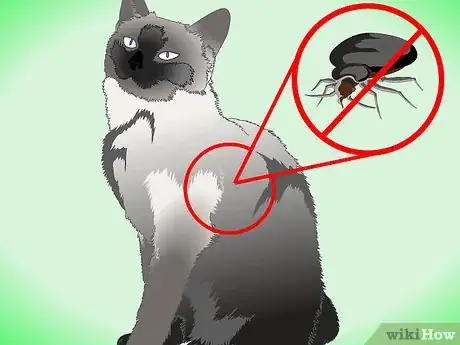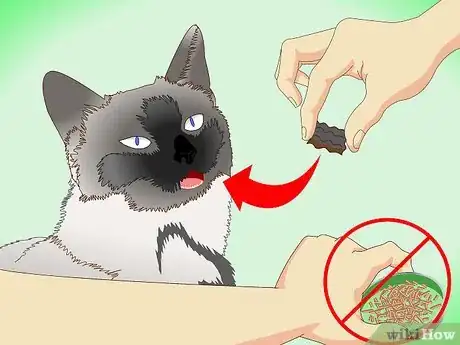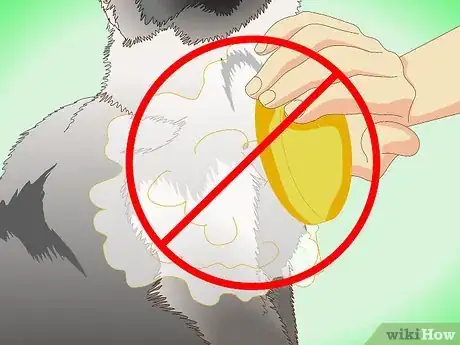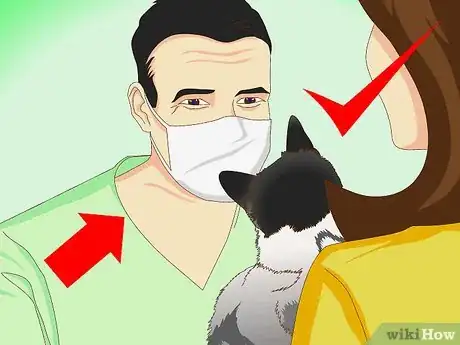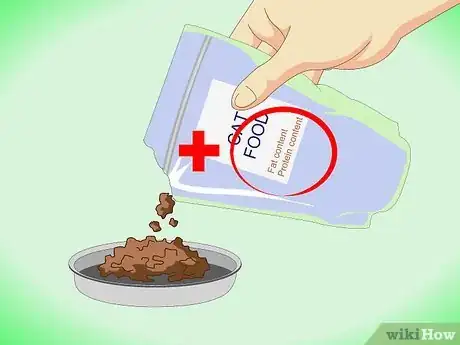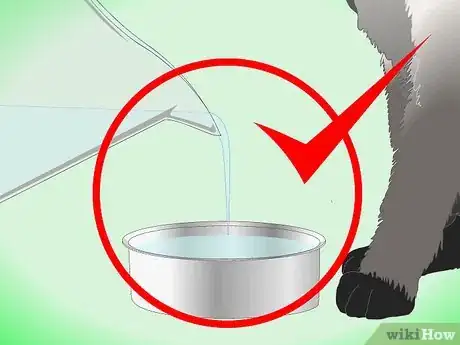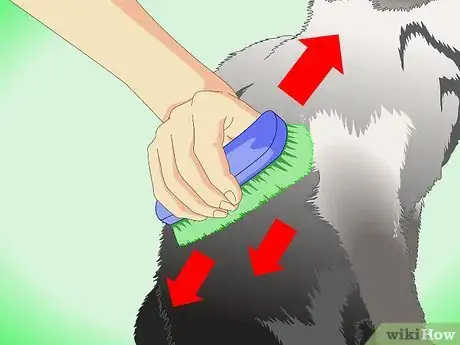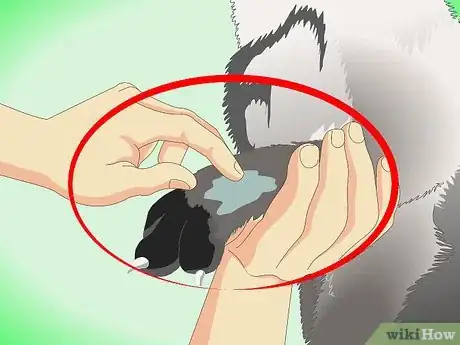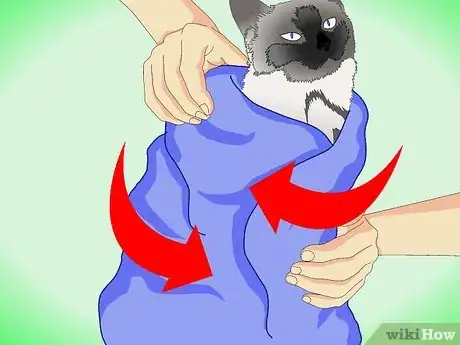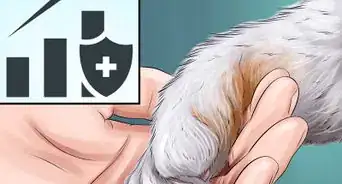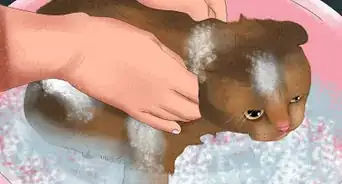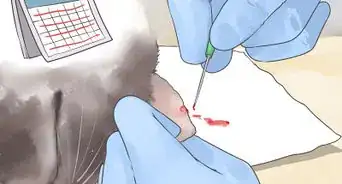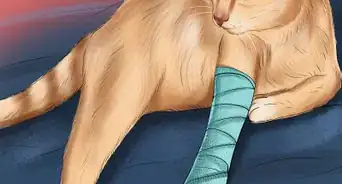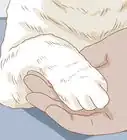This article was co-authored by Stephanie Abrams, DVM, MS, DACVD. Dr. Stephanie Abrams is a Board Certified Veterinary Dermatologist with over eight years of veterinary experience. She specializes in treating skin conditions in cats and dogs. Dr. Abrams earned a BA from Skidmore College and a DVM from Ross University School of Veterinary Medicine. After earning her DVM, she completed an internship at Tufts Veterinary Emergency Treatment & Specialties, followed by a residency in Dermatology at the Ohio State University School of Veterinary Medicine.
wikiHow marks an article as reader-approved once it receives enough positive feedback. This article has 19 testimonials from our readers, earning it our reader-approved status.
This article has been viewed 210,627 times.
Believe it or not, human beings aren't the only animals that can suffer from dandruff. Cats can also get dried-out skin that flakes off when rubbed or petted — just like people. While this is rarely a serious issue, it's nice to know what to do when you notice that your cat has this problem (especially if it ends up being the result of a skin allergy).[1] Luckily, treatment usually just takes a few simple steps, once you discover what's the underlying cause.
Steps
Eliminating the Root Cause
-
1If the cat is allergic to fleas, treat them. For most cats, one or two fleas aren't a serious problem. However, in the rare case that your cat has a flea allergy, even a few small bites can lead to dry, irritated, and flaky skin.[2] A vet can help you determine whether or not your cat has an allergy. If your cat has an allergy, the vet can also recommend treatment options.
- Common remedies for fleas include licensed pesticide shampoos and ointments proven to be effective. If your cat is at risk for an infection, the vet may also recommend antibiotics. Luckily, most cats recover quickly with flea control treatments.[3]
-
2Change your cat's diet if it is allergic to its food. Just like people, cats sometimes have allergies to the things that they eat. If you can't find an obvious cause for your cat's dandruff, this may be the explanation. Your vet can help confirm your suspicions.
- If your cat does have an allergy, you may need to switch to a different food at your vet's recommendation. If this keeps the cat from getting nutrients it needs, dietary supplements may be necessary.
- In some cases, switching dry food for wet food and adding a little fish oil to each meal can help keep a cat's skin moisturized.[4]
Advertisement -
3Keep your cat out of hot, dry weather. It may not seem like a risk that's worth worrying about, but cats can have their skin damaged by the weather. This is especially true for cats with thin coats (or none at all). Hot, dry conditions can lead to dried-out skin and even sunburn, so let your cat stay indoors when it's scorching out.
- Drier winter months can also be a source of flaky skin if your cat lies next to a heater or fire, even if there's less of a risk of sunburn.
-
4Avoid bathing your cat too often. Cats aren't like people in terms of bathing needs. They're quite good at keeping themselves clean, so they only need to be bathed very infrequently. Unless your cat's coat is visibly dirty, oily, or matted, you won't usually need to bathe it more than a few times per year.[5] Bathing the cat more often can strip the essential oils from its skin, leaving it dried-out and flaky.
- If you have a cat that's amenable to being bathed, though, there are several moisturizing shampoos that you could use.
- If you believe your cat's skin is dry due to an allergy, a bath can help remove the allergen. That said, some allergies are caused by diet and, in such cases, a bath will not have the desired effects.
- See our article on bathing a cat for help if you do need to wash your cat.
-
5Take your cat to a vet for a medical diagnosis. The causes for dry skin above are just a few of the most common possibilities. A wide variety of medical conditions (some serious, some not) can also cause dry skin. Only a vet can rule out these causes, so don't hesitate to get professional help. Just a few other causes for dry skin include:[6]
- Diabetes
- Seborrhea
- Hyperthyroidism
- Ringworm
- Malassezia
Things to Do at Home
-
1Slightly increase the fat in the cat's diet. Sometimes, a cat simply isn't getting enough of the right nutrients to keep its skin healthy. In this case, its diet may call for a little more fat. Try switching to slightly fattier cat food or adding more fat to its meals yourself.
- One healthy way to do this is to offer the cat fish, which contains healthy Omega 3 fatty acids. You can also try adding healthy oil supplements to your cat’s current food.
- If your cat has any existing health issues, talk to a veterinarian before changing their diet.
- Since cats are typically fastidious groomers, applying topical medications usually isn't a good option to treat skin dryness, because they're very quick to groom it off of them. To remedy that, systemic changes in their diet tend to work better.
-
2Ensure the cat is getting plenty of water. Dehydration can also cause dry, flaky skin. Most cats don't need a lot of water, but since it's important for the cat's health and it doesn't contain any calories, there's no reason not to provide your cat with plenty of clean water every day.
- Change its bowl frequently to ensure it always has good water to drink. It's also a good idea to wash the water bowl from time to time to kill any bacteria in it.[7]
-
3Give the cat a gentle brushing. An occasional brushing can remove dead skin flakes, reducing dandruff. Use a gentle cat brush and stroke in the direction of the hair. Don't use too much pressure — you want to stroke, not scrub.
- Always brush gently and stop right away if you notice irritated skin or signs of pain.
- Remember, though, that cats don't necessarily need help grooming, outside the occasional help from a brush or a comb. Their tongues are rough and designed for grooming.
-
4Use a gentle ointment. Believe it or not, there are moisturizing lotions and topical ointments designed for cats with dry skin. Your best chance for finding these will be your local pet store, but if you can't find any there, your vet may be able to recommend some. You can also easily find these products available online.
- Only buy well-regarded, quality products for use on your cat. The best products will have lots of positive reviews from happy cat owners.
-
5Give the cat a hot towel wrap. The gentle, warm moisture from a hot towel can help soothe dried-out skin and leave the cat feeling refreshed. Follow the steps below:
- When your cat is in a calm, approachable mood, find a clean towel or rag and soak it in hot water. The water shouldn't be too hot for you to hold your hand in.
- Once it's soaked, take the towel out and wring it until it is not dripping wet anymore.
- Drape the towel over the cat where the dandruff spots are. Gently keep the towel in place while you hold the cat. Let it sit this way for five minutes while you offer it petting and affection to keep it calm.
Expert Q&A
-
QuestionMy cat got flaky skin by her tail bottom?
 Pippa Elliott, MRCVSDr. Elliott, BVMS, MRCVS is a veterinarian with over 30 years of experience in veterinary surgery and companion animal practice. She graduated from the University of Glasgow in 1987 with a degree in veterinary medicine and surgery. She has worked at the same animal clinic in her hometown for over 20 years.
Pippa Elliott, MRCVSDr. Elliott, BVMS, MRCVS is a veterinarian with over 30 years of experience in veterinary surgery and companion animal practice. She graduated from the University of Glasgow in 1987 with a degree in veterinary medicine and surgery. She has worked at the same animal clinic in her hometown for over 20 years.
Veterinarian It might be the cat has difficulty turning around to groom this area. Brush daily to give her a helping hand, and see if this helps.
It might be the cat has difficulty turning around to groom this area. Brush daily to give her a helping hand, and see if this helps. -
QuestionOur cat is hairless on back and bottom and has very dry skin and it is like dandruff. How can I fix this?
 Pippa Elliott, MRCVSDr. Elliott, BVMS, MRCVS is a veterinarian with over 30 years of experience in veterinary surgery and companion animal practice. She graduated from the University of Glasgow in 1987 with a degree in veterinary medicine and surgery. She has worked at the same animal clinic in her hometown for over 20 years.
Pippa Elliott, MRCVSDr. Elliott, BVMS, MRCVS is a veterinarian with over 30 years of experience in veterinary surgery and companion animal practice. She graduated from the University of Glasgow in 1987 with a degree in veterinary medicine and surgery. She has worked at the same animal clinic in her hometown for over 20 years.
Veterinarian This doesn't sound normal and the cat may well have a medical problem, such as an allergy. Treat her against fleas regularly, and if things don't improve then a visit to the vet is essential.
This doesn't sound normal and the cat may well have a medical problem, such as an allergy. Treat her against fleas regularly, and if things don't improve then a visit to the vet is essential.
References
- ↑ http://pets.thenest.com/rid-cat-dandruff-3546.html
- ↑ http://pets.thenest.com/can-flea-allergy-cause-dandruff-cats-9802.html
- ↑ http://pets.thenest.com/can-flea-allergy-cause-dandruff-cats-9802.html
- ↑ http://pets.thenest.com/can-flea-allergy-cause-dandruff-cats-9802.html
- ↑ http://www.petco.com/Content/ArticleList/Article/19/2/1888/Bathing-Your-Cat.aspx
- ↑ http://www.cat-world.com.au/cat-dandruff
- ↑ http://pets.webmd.com/cats/guide/dehydration-cats?page=2
- ↑ http://www.petobesityprevention.org/ideal-weight-ranges/
About This Article
To treat dry skin on your cat, try giving it a warm towel wrap by soaking a towel in warm water, then wrapping it around your cat. Alternatively, increase the amount of fat in your cat's diet to help it get the right nutrients for healthy skin. If the dry skin is caused by a flea allergy, treat your cat with a pesticide shampoo. You can also help keep dry skin at bay by ensuring your cat isn't exposed to too much sun and hot weather, which can cause its skin to dry out and burn. For tips on what to do if your cat is allergic to the food you're giving it, read on!
